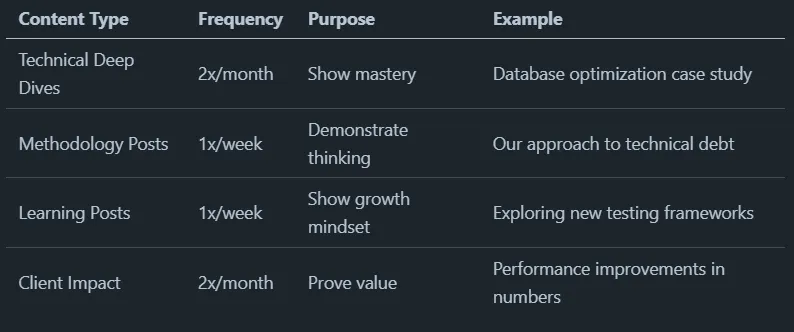Every agency says they're "experts."
Scroll through LinkedIn and you'll see it everywhere:
-
"Leading experts in [technology]"
-
"Premier solutions provider"
-
"Industry-leading agency"
But here's what I've learned after working with dozens of agencies: Real expertise doesn't need labels. It shows through in your daily work, your problem-solving, your thinking process.
Your LinkedIn company updates are the perfect place to demonstrate this expertise - without ever calling yourself an expert.
The Authority Paradox
Most agencies fall into a trap on LinkedIn:
-
They label themselves as experts
-
They share surface-level content
-
They wonder why no one sees them as authorities
Meanwhile, the agencies that actually win clients:
-
Share specific solutions
-
Document their thinking
-
Let their work speak for itself
Let me show you how to do the latter.
The Content Architecture That Works
Think of your LinkedIn content like your software architecture - it needs structure, patterns, and purpose:
1. Solution Stories (40%)
These are your production-grade posts. Real problems you've solved:
-
Technical decisions and their outcomes
-
Architecture improvements and their impact
-
Performance optimizations with metrics
-
Security enhancements and methodologies
Example format:
Problem: Client's API was timing out under load Investigation: Found N+1 queries in key endpoints
Solution: Implemented database indexing + caching Result: 200ms average response time (down from 2s)
2. Thinking Framework Posts (30%)
Share how your agency approaches problems:
-
Decision-making processes
-
Technology evaluation criteria
-
Project planning methodologies
-
Risk assessment frameworks
Real example:
When choosing a new technology stack, we assess:
1. Team learning curve
2. Community support
3. Production readiness
4. Long-term maintenance
5. Client's existing architecture
3. Work-in-Progress Posts (20%)
Show your learning and iteration:
-
New technology explorations
-
Failed approaches and pivots
-
Team learning experiences
-
Ongoing experiments
4. Culture Through Work (10%)
Don't just talk about culture - show it through work:
-
Code review practices
-
Knowledge sharing sessions
-
Client collaboration approaches
-
Team problem-solving stories
[visual CTA: "Use LiGo to structure your agency's expertise sharing"]
Translating Work into Content
Here's the system I've seen work best:
-
Capture Knowledge in Real-Time
-
Set up a dedicated Slack channel
-
Create simple documentation templates
-
Record quick voice notes after solving problems
-
Take screenshots of interesting solutions
-
-
Structure into Templates
Problem-Solution Template:
- What we faced
- Why it mattered
- How we approached it
- What we learned
- Results & metrics
Process Template:
- Challenge we handle often
- Common pitfalls
- Our methodology
- Key considerations
- Example scenario
-
Add Context Layers
-
Industry impact
-
Client benefits
-
Future implications
-
Broader applications
-
The Positioning Matrix
Use this matrix to ensure your content builds authority:

Common Pitfalls to Avoid
-
The Buzzword Trap
-
Instead of: "We leverage cutting-edge AI"
-
Try: "Here's how we improved recommendation accuracy by 23%"
-
-
The Vague Value Prop
-
Instead of: "We deliver high-quality solutions"
-
Try: "Here's how we reduced AWS costs by 40%"
-
-
The All-Theory Problem
-
Instead of: "5 ways to improve performance"
-
Try: "How we improved load time from 3s to 0.8s"
-
Your Next Steps
-
Today:
-
Set up your content capture system
-
Create your first solution template
-
Document one recent technical win
-
-
This Week:
-
Draft three different types of posts
-
Get team input on technical accuracy
-
Schedule your content mix
-
-
This Month:
-
Build your template library
-
Create your positioning matrix
-
Establish your posting rhythm
-
Ready to create a coherent system between personal and company profiles? Learn how here → "Creating a Content System Between Personal and Company Profiles"
LiGo Update (2025): LiGo now supports both personal profiles AND LinkedIn company pages (early access). While we can help you manage company page content efficiently, we strongly recommend prioritizing personal profiles for maximum ROI based on industry data - personal profiles consistently generate 5-20x better engagement and lead generation results. However, for agencies managing both channels, LiGo helps maintain consistent brand voice without doubling your workload. Explore our company page resource hub →
This article is part of our Agency Growth on LinkedIn series. New to LinkedIn company pages? Start with our guide on turning your company page into a lead generation engine. Want to get your team involved? Check out our employee advocacy guide_.




